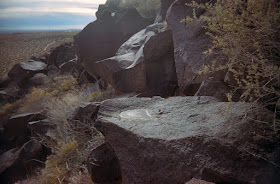The distance between the basalt cliffs and the housing developments is perhaps better expressed in the dimension of time. The suburbs only go back decades, while the lava cap of the mesa was laid down around 150,000 years ago. Though that age predates human encroachment by well over 100,000 years it is still relatively young by geologic standards. The area between the small volcanic peaks and the escarpment's cliff face probably looks much as it did shortly after the lava cap was formed.
The slope below the rim is littered with great blocks of basalt which erosion has broken away from the face of the escarpment. Spaces between the boulders are packed with dried tumbleweeds and other vegetation which often conceals deep clefts. During the day one sees a few rabbits among the rock rubble while hawks glide noiselessly from one favored perch to another. A pair of ravens will usually swoop in to voice their displeasure at any intruders. Large rattlers are seen among the rocks frequently during the warm months, but in cold weather you can put your feet anywhere they will fit with only the risk of broken bones as a deterrent.
Although the litter and noise of the city is not far distant, little of that seems to reach the top of the cliffs. The prevailing silence and the dramatic jumble of sharp edged boulders instill a sense of an unbroken continuum of Time. Looking east you see the present and very recent past, while turning your gaze north, south or west shows you the world much as it was many millennia in the past.
Ancient rock art can be found all along the escarpment. The images were laboriously pecked through the patina of the hard basalt to provide a contrasting design on the dark surface. Most of the images date from the last few hundred years of occupation of the valley by Pueblo people, but a few go back thousands of years to the area's first inhabitants. Later arrivals during the last couple centuries have added religious iconography, graffiti and bullet scars.





I have some places like this near me. Close to civilization but far enough away to afford some needed quiet, piece and of course...photo opps.
ReplyDeleteI've always placed a high value on places where I am unlikely to encounter other people. I don't really have a good explanation for that preference, but I'm glad I have always been able to find places like that wherever I've lived.
ReplyDeleteHa! I meant to say "peace" not piece. I wish you could edit these comments after you've submitted them!
ReplyDeleteYes, that is true. Even I cannot edit them. If it is any comfort, I did not notice the typo when I replied.
ReplyDeleteI should add that, while I cannot edit comments, I am able to delete them.
ReplyDeleteFine blog, fine writing.
ReplyDeleteI've been scanning (Nikon V) Kodachromes from 1973 and inkjet printing them. Nikon V's Digital Ice deals flawlessly with color negs, Ektachrome, and B&W but due to Digital Ice's confusion with Kodachrome, which is literally complex B&W, it renders strangely. My main fall back with Kodachrome is to convert to B&W via NIK, tho I'm sure other approaches to PS would work just as well (tho more laboriously). Kodachrome, scanned and printed that way, can make beautiful B&W.
I print only with inkjet (Canon Pro 10). Because I can't print bigger than 13X19 or print for stretcher bars I recently had ABQ's Pat Carr print a pair of 30X40ish very graphic B&Ws on canvas with stretcher bars for girlfriend's daughter's new home in CA. Carr uses a pair of huge Canon printers and an Epson (for printing on aluminum).
https://www.facebook.com/carrimagingartservices/
djon43@yahoo.com Happy New Year... John Kelly
Thanks for that link. I gave up printing a while ago because I just couldn't get myself to pay for those ink cartriges for my Epson. I'll give Carr a try.
ReplyDeleteHi Mike... sorry about long-delayed comment :-)
ReplyDeleteIf I didn't shoot intending to print I'd sketch (wish I could). My mother started me shooting/developing/printing when I was 6 or 8. I rarely shoot without planning (or hoping) to print. Not into snapshots. I'm 79 fwiw. I love inkjet (Canon=zero grief) and usually make a large print (or several) after going somewhere, thinking to find something interesting. My goal is usually a print-or several. similar to your blog, usually on 11X17 paper. Currently relying on Pentax K70 and Samsung NX 500 (for indoors). Am currently scanning and discarding (viking-funerals).
Shoot me an email :-) JK
I made quite a few prints with a four-color Epson printer and thought they were ok quality. The ink cost seemed excessive to me, but more importantly I really had little use for actual prints. My wall space is pretty limited and squirriling away prints in an album seemed kind of pointless. I organized a couple exhibits for the NM Film Photographers, but that was more work than fun.
ReplyDeleteHi Mike.. couldn't speak, your blog popped up. I've been reading House Of Rain (again) by Craig Childs...relates directly to your blog and one print I've made :-)
ReplyDeleteAs to "pointless" printing. My oldest friend/couple recently left their Oakland home for an almost-assisted community in Walnut Creek. He's been photographing and printing forever so has boxes full of good stuff but little room to hang it.
He will go back to storage (once more) with teeth gritted, has been delaying the most emotional for last. I did most of mine a few months ago, with the advantage of being attached mostly to the last couple of years.
I've discovered that I'm project-oriented. My "family stuff" (going back to 19th C) and an accidentally acquired Russian historic collection reside in compact archival boxes and a dedicated hard drive. I'm currently printing a dozen ridiculous neo-archaeological images, having labored successfully, on and off, for several weeks to just one: Comb
Ridge (Utah).
Happy Thanksgiving, JK